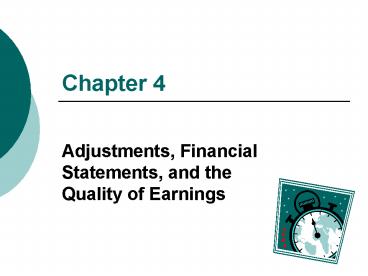Adjustments, Financial Statements, and the Quality of Earnings - PowerPoint PPT Presentation
1 / 21
Title:
Adjustments, Financial Statements, and the Quality of Earnings
Description:
To close Papa John's Restaurant Sales Revenue account, the following entry is required: ... To close Papa John's Cost of Sales - Restaurants account, the ... – PowerPoint PPT presentation
Number of Views:38
Avg rating:3.0/5.0
Title: Adjustments, Financial Statements, and the Quality of Earnings
1
Chapter 4
- Adjustments, Financial Statements, and the
Quality of Earnings
2
Business Background
Revenues are recorded when earned.
Expenses are recorded when incurred.
Matching principle
Revenue principle
Because transactions occur over time, ADJUSTMENTS
are required at the end of each fiscal period to
get the revenues and expenses in the right
period.
3
The Unadjusted Trial Balance
- A listing of individual accounts, usually in
financial statement order. - Ending debit or credit balances are listed in two
separate columns. - Total debit account balances should total
credit account balances.
4
(No Transcript)
5
The Unadjusted Trial Balance
- If total debits do not equal total credits on the
trial balance, errors have occurred . . .
in preparing balanced journal entries.
in posting the correct dollar effects of a
transaction.
in copying ending balances from the ledger to
the trial balance.
6
Adjusting Entries
- There are two types of adjusting entries.
7
Accounting Estimates
- Certain circumstances require adjusting entries
to record accounting estimates. - Examples include . . .
- Depreciation
- Bad debts
- Income taxes
8
Depreciation
This is a cost allocation concept, not a
valuation concept.
Systematic and rational allocation of a
long-lived assets cost to the multiple periods
it is used to generate revenue.
9
Recording Depreciation
The required journal entry requires a debit to
Depreciation expense and a credit to an account
called Accumulated depreciation.
A Contra-Asset account.
10
Financial Statement Preparation
- The next step in the accounting cycle is to
prepare the financial statements. . . - Income statement,
- Statement of stockholders equity,
- Balance sheet, and
- Statement of cash flows.
11
Note that this statement has ONLY revenues
expenses!
Earnings Per Share (EPS) must be reported on the
income statement.
12
Statement of Stockholders Equity
- Net income appears on the statement of
stockholders equity as an increase in Retained
Earnings.
13
Balance Sheet
338,000 cost 85,500 accumulated depreciation
and amortization.
14
Balance Sheet - Continued
Remember that Total liabilities and stockholders
equity (433,000) must equal Total assets
(433,000).
15
Statement of Cash Flows
- This statement is a categorized list of all
transactions of the period that affected the Cash
account. The three categories are . . . - Operating activities,
- Investing activities, and
- Financing activities.
16
The Closing Process
- Two steps are used in the closing process . . .
- Close revenues and gains to Retained Earnings.
- Close expenses and losses to Retained Earnings.
How to Close the Books!
17
The Closing Process
To close Papa Johns Restaurant Sales Revenue
account, the following entry is required
18
The Closing Process
- If we close the other revenue accounts in a
similar fashion, the retained earnings account
looks like this . . .
19
The Closing Process
To close Papa Johns Cost of Sales -
Restaurants account, the following entry is
required
20
The Closing Process
- If we close the other expense accounts in a
similar fashion, the retained earnings account
looks like this . . .
21
The Closing Process
- Finally, we close dividends to Retained
Earnings and the account balances out to 169,241
and looks like this . . .

